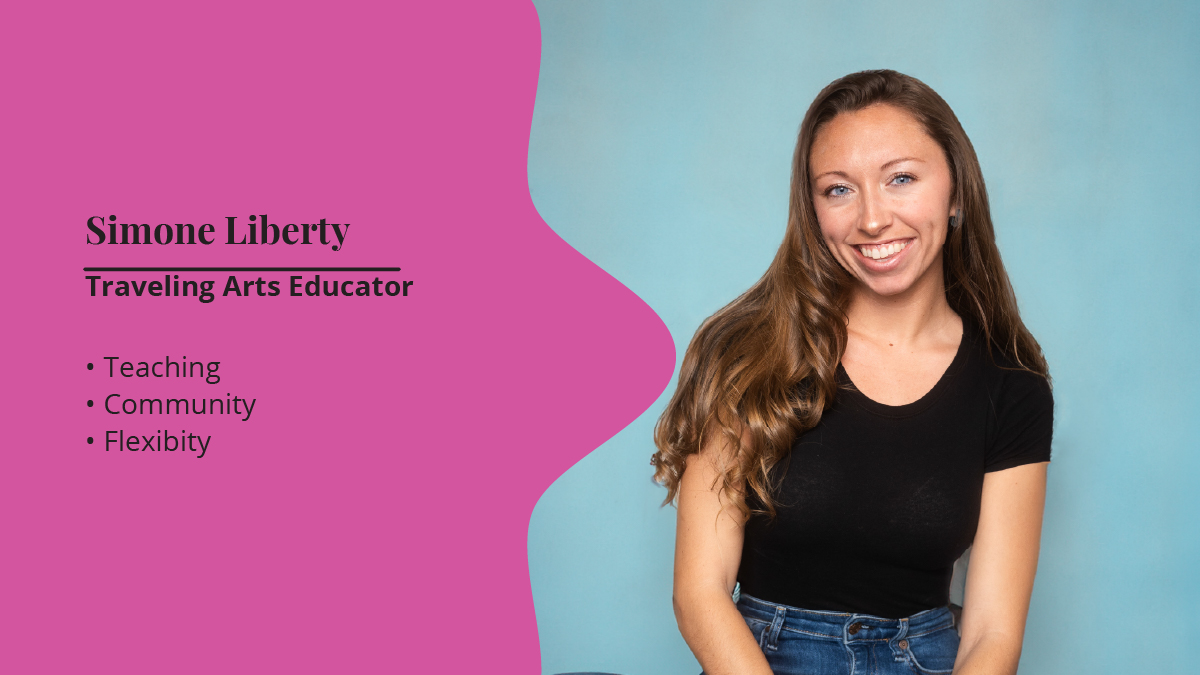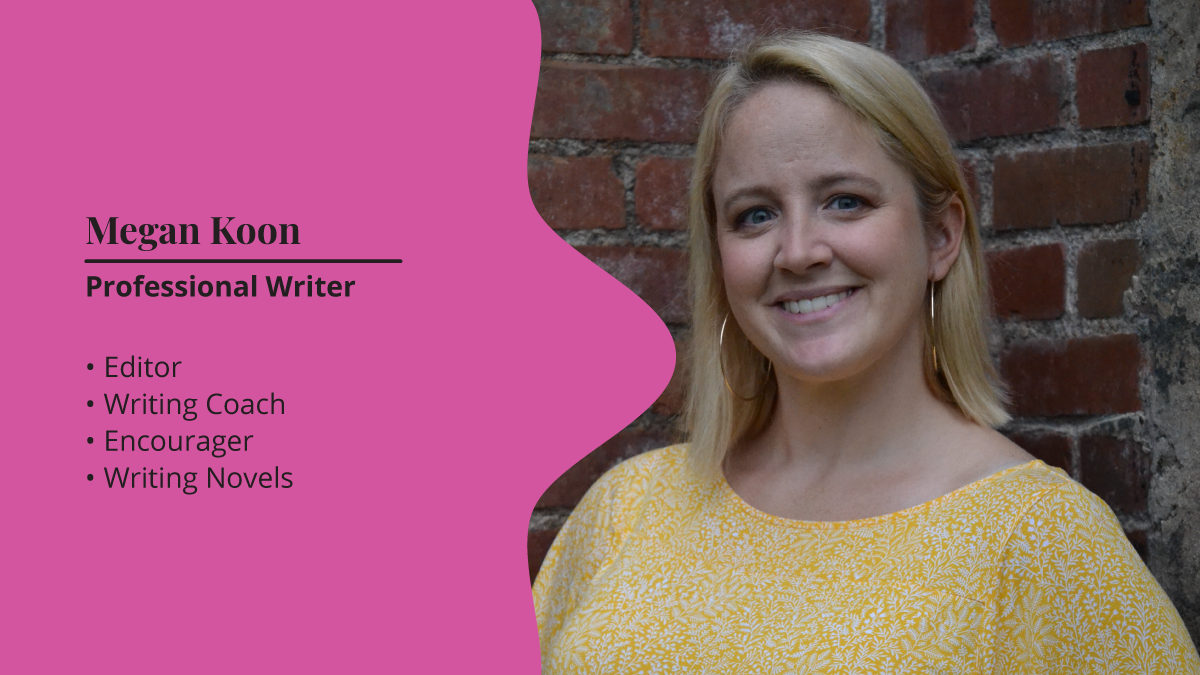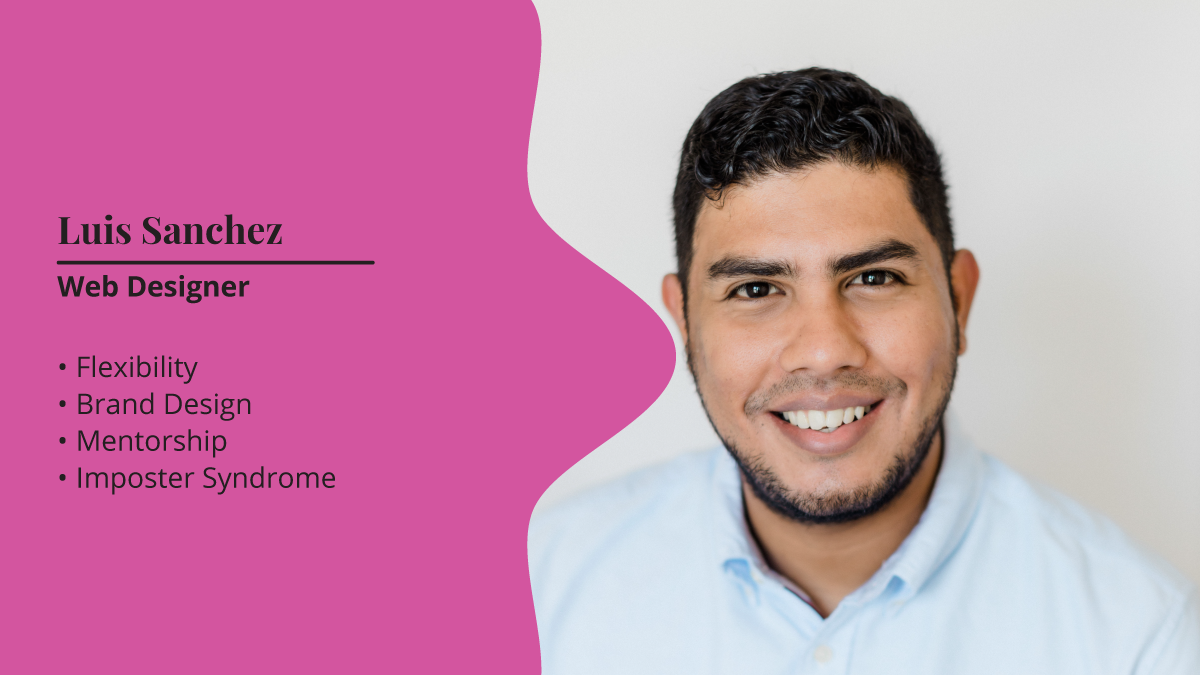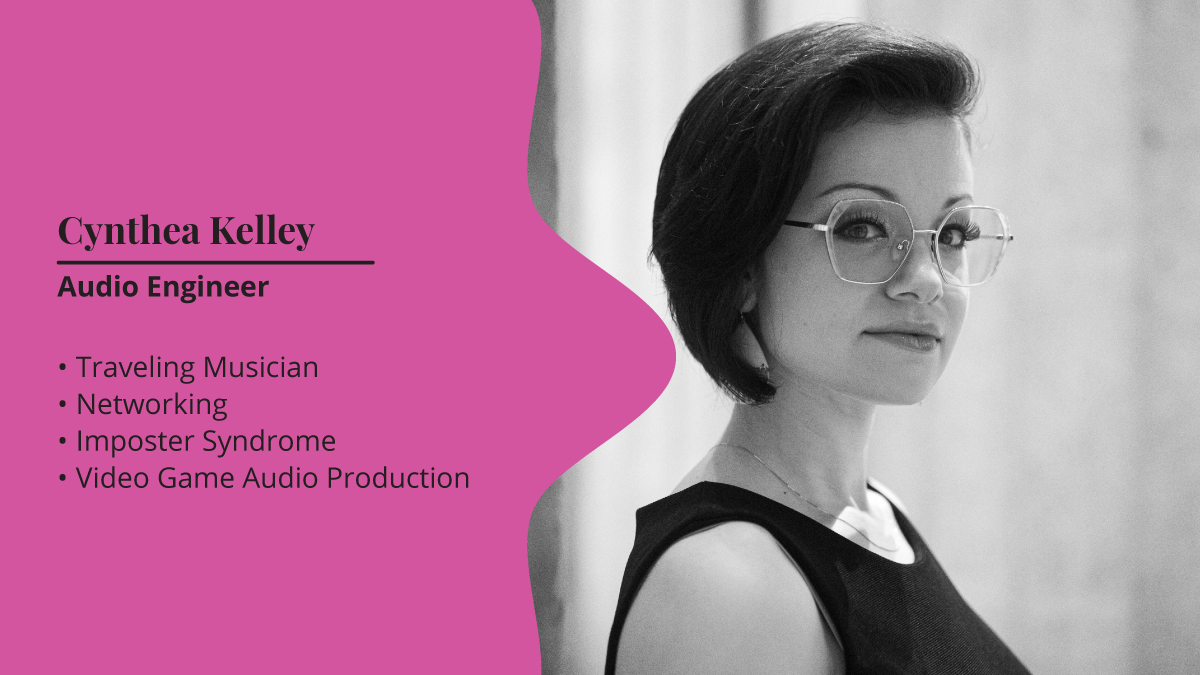“I really love to extend art and creativity for everyone. Art for all. Art for everybody.”
Simone Liberty is a full-time Teaching Artist based in Charleston. As a Teaching Artist, or traveling arts educator, Liberty teaches Arts Integration in schools throughout Charleston, Dorchester, and Berkeley counties. Arts Integration uses visual and performing art forms including dance, art, and theatre, connecting them to core curriculum subjects such as math, science, and ELA.
Interview
Transcript
Simone Liberty
I’m Simone liberty. I’m from Connecticut originally, but I’ve been down here in Charleston since 2015, in the fall.
Emma Plutnicki
So, can you please tell us what you do for work and what your official job title is?
Simone Liberty
Yeah, sure. So, I am a teaching artist would be my official job title. And so what that means is, essentially, I’m a traveling arts educator. Um, I go into, um, lots of different schools at this point, although a teaching artists doesn’t have to be just confined to schools; they are community art educators, so they could go and do workshops for adults or other communities as well. Right now, my work has me going into schools kind of all over the Charleston, Dorchester,and Berkeley counties.
Emma Plutnicki
Very cool. How long have you been doing that?
Simone Liberty
I’ve been full-time as a teaching artist for about two years now.
Emma Plutnicki
So, how did you end up doing this? How did you know that it was a profession that you could actually pursue? How did you know that you wanted to do this?
Simone Liberty
Yeah, so. It was kind of funky. So, I have to go back to tell you about my undergraduate degree at the College of Charleston. I was an arts management major, and that’s I graduated in 2019 with my bachelor’s degree. And while I knew that I wanted to roll right into a master’s program, I also had a desire to start connecting with some of the organizations around Charleston in the arts.
Simone Liberty
So, the best thing about my arts management experience undergrad was that we had some great adjunct faculty members, and one of my professors was Catherine Brack, who at the time was the Director of Development at the Gaillard Center. So, I went in, and I was just kind of trying to pick her brain about what she does for work. And while I was there, she invited me to go and see their youth theater program in the summertime. So, it was a summer camp. And she said, You know, it’s gonna be super cute. They do these every summer. So, would you, you know, just come and check it out? And totally adorable. I fell in love with just watching the kids on stage. And, um, it reminded me of some work that I had done in the summers during my undergraduate experience.
Simone Liberty
So, I met Sterling DeVries, who is the Director of Education at the Gaillard center, and still is, um, and just told her how interested I was in, um, arts education. So we talked for a while about that. And I ended up actually writing a letter, um, in email form, to both Catherine and Sterling; I’m basically creating myself a position at the Gaillard. I ended up getting that position, but the catch was what I really wanted to do was work about part-time in the Education Department and part-time in the Fundraising and Development Department. And instead, what they could offer me because of, um, budgetary needs, was a full-time or it was still a part-time position in development while I was in graduate school. And so I ended up raising funds for specifically the education program at the Gaillard while I was there for about two and a half years and absolutely loved the work that I was doing because I got to raise the funds that were supporting the arts education. But, I wasn’t doing it myself. I really wanted to be with the kids specifically. So, I started to talk to Sterling more about that. And she eventually ended up asking me to be one of their teaching artists for the summer camp that I went and saw originally. So, that was kind of my bridge into teaching artistry.
Simone Liberty
It started out as just teaching summer camps. And more and more as I got my name out there and started to network myself a little bit harder and got connected with some other community partners, I’m now able to say that I’m full-time as a teaching artist.
Emma Plutnicki
Amazing. That’s a great story. So, nowadays, how would you say the split is between working in schools and working behind a desk? What, does your typical day kind of look like?
Simone Liberty
Yeah, so it really depends. I used to love routine. Unfortunately, this job has no routine. So, if I’m in a school, it’s either in school after school, or maybe summer camps.
Simone Liberty
So let’s take today, for example, today, I am going to be in a school, but my school time doesn’t start until 12:45. And from 12:45, until the end of their school day, basically, I’ll be teaching different classes, and then I do an after school program. So, that meant that I had a couple of hours this morning to be on my laptop. And that’s what I have been doing and will continue to do after we get off of this Zoom call. This, I would say, looks like a pretty typical day. If there were such thing as a typical day, where you know, it’s a balance between computer work and then being face to face with students for me, but like I said, a teaching artist can also be face to face with adults in the community or anything like that, too.
Emma Plutnicki
Yeah, so do you think it’s been I mean, you said that you kind of paved your way to find this position, but has it been challenging to work within this field? What kind of challenges do you see on a day-to-day basis? And how do you kind of overcome those?
Simone Liberty
Yeah, so it has been difficult to call this a full-time career path. As I mentioned before, you really have to be intentional with networking and getting yourself out in the community, so that people know who you are and what you do. And what I have found is that I’ll speak specifically to the Charleston area. Lots of people have questions or are generally confused about what a teaching artist does for their work, and I think that has to do with the broad nature of the role, you know, what, what age range do you like to work with? Or what’s the style of your workshops? Sometimes, when I’m working with different community members when I am going into schools, specifically, I’m doing arts integration. And so that’s making sure that it’s not just a dance or theater, workshop, I’m teaching dance and theater things, but it’s also teaching a core curriculum subject like math, or science or ELA.
Simone Liberty
So, all of those moving pieces they make a teaching artist change how they describe themselves. And so it’s just this really vast thing that hasn’t really been nailed down, nor do you want it to, because we’re creative individuals. So you want that breadth. So, all of that being said, it’s tricky to keep having the conversation of who are you and what do you do? And you know, what are your credentials? Because there’s not really credentials in geometry, there’s no certificate, there’s no degree in teaching artistry. But you know, that’s, that’s kind of the tricky part of it. And with that comes, where do you find your peers? You know, it can be a little bit isolating of a position if you don’t have community partners that you’re really in contact with. So, it’s just it requires lots of self initiation.
Emma Plutnicki
Yeah, and so as far as networking goes, how have you been able to network with people? Are there any events that you’ve gone to? Or is there anything within South Carolina programs or communities that you’ve found to kind of build those connections?
Simone Liberty
Yes. So, first and foremost, I will need to tell you about Engaging Creative Minds, which is one of my community partners, and one of the organizations that I do lots of work for. They’re kind of like a booking agent for teaching artists, and they have a whole roster of artists. All of these artists go into schools as well and do very similar things to what I’m doing, but just maybe in a different discipline, or the same. So, I focus on dance and musical theater. And so lots of those teaching artists I’ve been able to connect with through engaging creative minds, even if it’s just on an email basis, some of them I’ve been able to meet in person, even, you know, get coffee with and pick their brain about how they run their workshops. But that’s been a great help.
Simone Liberty
I should also call out professional connections that aren’t teaching artists have been very helpful in just understanding the field more broadly. And so I like to stay well connected with the South Carolina Arts Commission and also the South Carolina Arts Alliance, two separate things, but, the Arts Alliance is a nonprofit that is the statewide Arts Advocacy Organization. So, that, those two organizations or the agency and that organization have been great to be connected with so that I understand more about the South Carolina Arts field at large.
Simone Liberty
And then I find a lot of my personal connections to be from a part of my graduate program. So not only did I do the masters in public administration, but the College of Charleston also offers a certificate in Arts and Cultural management. So, a lot of the individuals from my cohort and I are still quite close. So, I would say that those are the couple of events and organizations that I stay connected with.
Simone Liberty
Perfect, and so throughout your journey so far, has there been any particular project or, I don’t know, a program that you’ve worked on that has had a significant impact on you, or that you hold, like, close to your heart, anything that stands out as being like a highlight of your career so far?
Simone Liberty
Yes. And actually, it’s it’s kind of a new one. But I’ve been really happy about this past couple of months now. So, I, for the past couple of years, have struggled with the question of what is my why. And I think that’s a really important question, especially for young professionals to be asking themselves when they’re going through, trying to find what they love to do for work, what you know, makes their workday feel like it’s fun, rather than work. And so what I’ve been working on is, I really love to extend art and creativity to everyone, art for all, art for everybody. And one thing that had been kind of gnawing at me for a while is that I love tap dancing. I’m not a ballerina, but I do love tap dancing, and I can’t teach that in most of the schools that I go into because there’s a prohibitive cost to tap dancing. Those tap shoes they start at $65 dollars. So, that’s just not possible for a lot of the students that I teach.
Simone Liberty
So, what I created last fall, I’m calling them Tip Taps. It is a low-cost tap accessory, I’ll call it. It’s not a replacement to a tap shoe. But it’s simply just a piece of metal that you can strap to any shoe. And I can now go in and teach tap dance workshops. Now it’s just one tap, it’s not the heels, but I can teach tap dance workshops to kids who might not have ever had a tap shoe on their foot before. So, this has been definitely a highlight. And it’s really brought me back to that, what’s your why? Because, like I said, my why is art for all and making sure that there are accessible ways to bring art into our community, even if it’s not in a traditional way.
Emma Plutnicki
As far as, skills that you possess, what do you think has helped you in this role? Clearly, you have ingenuity and creativity with projects like that. But are there any other skills that you’ve had that you think really advance your role?
Simone Liberty
That’s a good question. Yes, I want to say flexibility and not in the dancer way. But being flexible in your schedule, in your idea of what your day is going to look like in your goals, even. You know, sometimes you end up either under or overshooting in a goal that you have at, say, the beginning of the year or the beginning of a school year or semester, whatever it might be. Whether that’s a financial goal, a mindset goal, or a life, a work-life balance goal, whatever it is, there’s definitely an element of, like, entrepreneurship in craft. And it takes some flexibility.
Simone Liberty
There, there was another thing that I was thinking of well, ah, curiosity would be another one. That’s definitely been a skill that I’ve had to flex quite a lot, you know, ask lots of questions and kind of dive into who might be potential partners for you to go in and offer your teaching artistry to. So I would say, Yeah, curiosity and flexibility. Those would be the two skills.
Emma Plutnicki
Yeah, great. And so, just as we wrap up, do you have any advice for young professionals and college students who are trying to make a path in the creative world and looking for a job similar to yours?
Simone Liberty
Stay connected to what brought you to the arts in the first place. This has been something that I’ve been trying to get back to the last year, I would say, you know, we probably all landed in arts management or arts administration or wanting to be in the creative field because we are creatives, and we are artists, or at least we say like, oh, I used to be. It’s not gone, and it doesn’t need to be. So, my advice to young professionals is to find that adult dance class, find the you know, down here in Charleston, we’ve got like Redux that offers adult art workshops. Find those opportunities to stick with your craft and make sure that that stays in your practice. So, I think the reason that I’m saying this is because it really does help you to fill in that work-life balance, and at the same time might let you draw some connections towards your why, why you’re doing this.
Emma Plutnicki
Great. That’s such good advice. Okay. So, thank you so much for joining us. Is there anything else you’d like to add about your profession, your career or anything else?
Simone Liberty
Oh, my gosh, we need more teaching artists. Please. You know, there’s there is no lack of demand. And also, I think that the field of teaching artistry is growing at just an exponential rate in South Carolina at large. I do know that there’s planning to be a Teaching Artists Forum in the fall by the South Carolina Arts Commission. And I think they’ve, they always have community partners on things like that. So yes, you know, look out for things like that if the idea of teaching artistry is interesting to you. I also would say to get connected with Tag, which is the Teaching Artists Guild. There’s other national and even international resources for teaching artists to kind of connect with so that you can explore the field more and of course, if you have anyone up your way that would like to connect with me about teaching artistry with more questions, feel free to send them my way.



